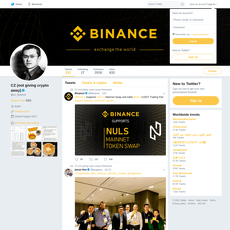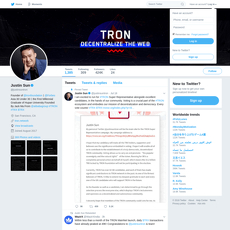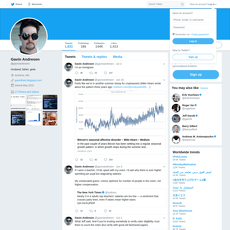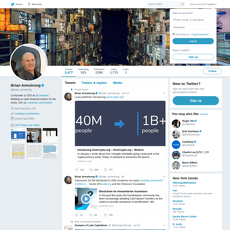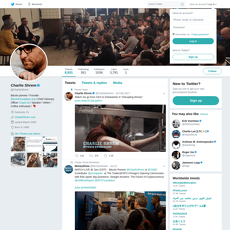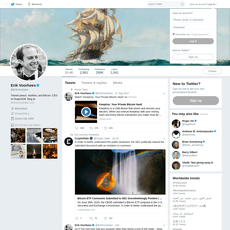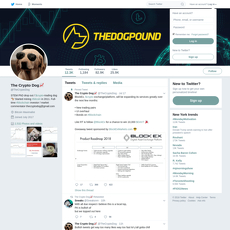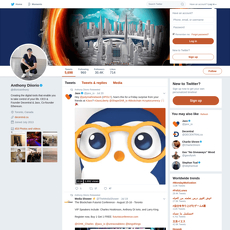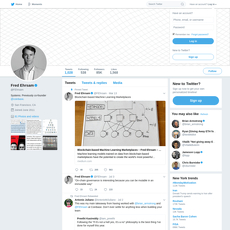Emin Gün Sirer Review
Emin Gün Sirer
twitter.com
Emin Gün Sirer review guide: everything you need to know + FAQ
Have you ever wondered why so many serious crypto builders and investors pay close attention to Emin Gün Sirer’s tweets and interviews—while the rest of Crypto Twitter feels like static?
If you’re trying to cut through the noise and decide whether his insights are worth your time, you’re in the right place. I’m going to set the stage: what problems most people run into when evaluating voices like his, how this guide will help, who will benefit most, and how I personally review influential people in crypto.
Describe problems or pain
Let’s be honest—on Crypto Twitter, volume often beats substance. It’s hard to tell who’s shipping real tech versus who’s posting spicy takes for engagement. Add technical jargon, tribal debates, and market hype, and it becomes nearly impossible to get clean, useful takeaways you can act on.
- Information overload: Threads on consensus, TPS, and “finality” often read like marketing, not engineering. You get claims, not methods.
- Conflicting narratives: Communities frame benchmarks to favor their stack. Without context, you can’t compare apples to apples.
- Hype risk: Hot takes during volatility can look like signals—but they’re really sentiment spikes. Acting on them can be costly.
- Signal distortion on social platforms: Research has shown false or sensational posts travel faster than careful analysis. For example, an often-cited study in Science found that false news spreads “farther, faster, deeper” on Twitter than the truth (Vosoughi et al., 2018).
- Scam noise: Industry reports consistently flag scams and misleading promotions as a persistent issue, which makes independent verification essential (Chainalysis Crypto Crime resources).
Bottom line: Not all loud voices are equal. You need a simple way to separate engineering signal from engagement bait.
Promise solution
This guide maps out a straightforward path: who he is, what he’s built (Avalanche), how to read his Twitter feed without getting whipsawed by tribal debates, what pitfalls to avoid, and simple checks to verify claims. I’ll also include a quick FAQ and practical resources so you can move from “interesting thread” to “actionable insight.”
Who this guide is for
- Crypto investors looking for credible signals that translate into real-world outcomes
- Builders and researchers who want technical context without fluff
- Newcomers who want a trustworthy entry point into Avalanche and the work behind it
How I review people
I use a simple, repeatable framework designed to reduce bias and catch red flags early:
- Verifiable track record: Code contributions, peer-reviewed work, shipped products, and whether claims are backed by reproducible data.
- Clarity of communication: Do they explain assumptions and trade-offs? Do they link to methods, repos, or papers when making strong claims?
- Conflicts of interest: Everyone has them. The question is whether they’re disclosed and whether statements align with incentives.
- Consistency over time: I look at how positions evolve across market cycles. Are they reactive to price or grounded in long-term research?
- Reality check: outcomes: Do ideas lead to adoption, tooling, benchmarks others can replicate, or independent audits?
Here’s what that looks like in practice with any high-profile account:
- Claims vs. methods: If someone says “sub-second finality,” I check explorer stats, public RPC round-trip times, and whether “finality” means probabilistic or deterministic in their context.
- Benchmarks: I look for methodology: hardware specs, network topology, workload type, and whether the test is synthetic or production-grade. If those details are missing, I flag it.
- Replication: I scan for third-party confirmations—neutral researchers, independent validators, or audits that reproduced similar results.
- Source quality: Threads with data, code links, or papers get more weight than engagement-focused hot takes.
If you’re tired of tribal noise and want a clean, practical way to interpret what he says—and why it matters—you’ll want to keep going. Next up, I’ll answer the big question that sets the foundation for everything else: who is Emin Gün Sirer, what’s his track record, and why do so many serious people listen when he talks?
Who is Emin Gün Sirer? Credentials, track record, and why people listen
If you want a north star in crypto who actually ships code and publishes research, you’ll run into Emin Gün Sirer fast. He’s the Turkish-American computer scientist behind Avalanche, a long-time Cornell professor, and one of the rare voices who blends academic rigor with real-world execution.
“In crypto, the loudest person in the room isn’t the most useful. The one who can explain the trade-offs—and prove them—wins.”
That’s why builders, researchers, and VCs keep him on notification: he tends to be early, blunt, and surprisingly consistent.
Short bio and credentials
Here’s the snapshot that gives his opinions weight:
- Academic roots: Educated at Princeton (B.S.) and the University of Washington (M.S., Ph.D.), then a long-time professor of computer science at Cornell University, focused on systems and distributed computing.
- Research leadership: Co-founded and co-led IC3 (Initiative for Cryptocurrencies and Contracts), one of the most respected academic/industry bridges in crypto.
- Company builder: Co-founder and CEO of Ava Labs, the team behind Avalanche.
- Communicator: He’s been a go-to translator between academia and Crypto Twitter—technical enough for researchers, plain enough for founders. His writing on Hacking, Distributed made complex topics feel usable.
When he critiques a design, he usually brings data, experiments, or code. That changes the tone of any debate.
Early crypto involvement
Before “crypto” was a buzzword, he was already poking at the core ideas:
- 2003: Co-authored Karma, a peer-to-peer accounting/digital currency concept built for resource sharing in distributed systems—years before Bitcoin. It explored how to track value and behavior in decentralized networks. You can find one version of it here: Karma paper.
- 2013–2016: Published research that became household topics in crypto:
- Selfish mining showed how Bitcoin miners could exploit incentives and fork choice rules (arXiv), sparking industry-wide changes in how we think about security.
- Bitcoin-NG proposed a scalable blockchain protocol separating leader election from transaction serialization (NSDI ‘16), informing later throughput-focused designs.
- Public analysis: Through Hacking, Distributed, he dissected incidents like The DAO and other protocol failures with a builder’s lens—what failed, why it failed, and how to fix it.
These weren’t hot takes; they were warnings with math. That reputation stuck.
Notable publications at a glance
- Karma (2003): Early digital-currency-like accounting for P2P systems—economic incentives before “Web3” was a thing.
- Majority is not Enough: Bitcoin Mining is Vulnerable (2014): The “selfish mining” paper, co-authored with Ittay Eyal. Shook assumptions about 51% safety and miner incentives.
- Bitcoin-NG: A Scalable Blockchain Protocol (2016): A design for higher throughput without compromising decentralization, presented at USENIX NSDI.
Beyond specific papers, his work shows up in respected venues like IEEE Intelligent Systems, ACM SIGCOMM Computer Communication Review, ACM SIGOPS Operating Systems Review, and Lecture Notes in Computer Science. If you care about systems, incentives, and consensus, his Google Scholar page is a rabbit hole worth a weekend.
Why he matters in crypto today
He helped introduce the Avalanche consensus family and turned it into a running Layer 1 with one of the most active ecosystems. That puts him in a rare spot: he’s not just theorizing about consensus—he’s operationalizing it at scale.
- Builders follow him for real engineering trade-offs on scalability, safety, and performance.
- Researchers track him because the papers tend to age well and get cited widely.
- Investors listen because his posts often foreshadow roadmap shifts, new primitives, or where developer attention is moving.
There’s a reason his threads travel quickly across Discords and engineering chats: whether you agree with him or not, they’re anchored in systems thinking, not vibes.
So what exactly did he and his team build—and how is it different from other chains you know? If you’ve heard words like “subnets” or “probabilistic consensus” and wondered why people get excited, the next part breaks it down without fluff. Ready to check how Avalanche actually works in practice?
Avalanche and Ava Labs: what he built and why it’s different
Some chains promise speed. Avalanche was engineered for it. The core idea: get thousands of independent nodes to agree fast, without central bottlenecks, and give developers freedom to spin up their own chain when a single shared network becomes a ceiling.
“A subnet is a dynamic subset of Avalanche validators working together to achieve consensus on the state of one or more blockchains.” — Avalanche Docs
Avalanche consensus explained simply
Avalanche’s consensus flips the usual model. Instead of every node voting on every block, nodes repeatedly sample a small, random set of peers and ask, “What do you see as the right choice?” This repeated sampling causes the network to “tip” toward one outcome very quickly—what the research calls a metastable decision.
In practice, it feels like this:
- Fast finality: confirmations typically settle in seconds, targeting sub-second decisions under favorable conditions.
- High throughput: randomized sampling avoids all-to-all chatter; the network scales without blowing up communication costs.
- Probabilistic safety: like Bitcoin, finality is probabilistic—except Avalanche reaches extremely high confidence in a tiny number of rounds.
- Flexible VM layer: the same consensus engine runs different VMs (EVM for smart contracts, custom VMs for app-specific logic).
Why this matters to users: swaps on Trader Joe feel snappy, games don’t stall on block times, and stable UX does more to build trust than any slogan ever will.
If you want to read the actual research behind it, start with the paper that kicked it off: Snowflake to Avalanche: A Novel Metastable Consensus Protocol Family. It’s not just marketing—there’s a real algorithm with real parameters you can inspect.
Ava Labs: role and milestones
Ava Labs is the core engineering and commercialization team behind Avalanche. They ship the node client, build tooling, and push real-world uses in finance, gaming, and enterprise. A few anchors:
- Mainnet launch (2020): AvalancheGo (in Go) became the production client. Code is open source: github.com/ava-labs/avalanchego.
- EVM on Avalanche: the C-Chain runs an Ethereum-compatible VM, so MetaMask, Solidity, and popular tooling work out of the box.
- Subnets (app-chains): teams can launch their own networks with custom rules, fees, and allowlists. The popular stack is Subnet-EVM + Avalanche-CLI. For advanced builders, there’s HyperSDK to craft high-performance custom VMs.
- Cross-subnet messaging: Avalanche Warp Messaging (AWM) enables native communication between subnets without external bridges. The EVM-friendly Teleporter makes it easy for Solidity apps.
- Enterprise links: collaborations like Deloitte’s disaster-recovery platform and the AWS partnership reported in early 2023 help with compliance, hosting, and reach.
And yes, there are live subnets you can check today:
- DFK Chain by DeFi Kingdoms — a gaming-focused subnet built for its economy.
- Dexalot — a central limit order book (CLOB) DEX on its own subnet, designed to avoid the pool model’s MEV quirks. dexalot.com
- Swimmer Network — a gaming subnet initially backed by the Crabada team. swimmer.network
- Evergreen (institutional) subnets — permissioned environments (e.g., Spruce) for KYC’d participants testing on-chain finance workflows.
These aren’t just demos. They show how separate economies can run at their own speed and fee settings, without congesting a shared block space. That separation is the point.
Where Avalanche fits vs. other L1s
I don’t look for “winners.” I look for what a stack is optimized for. Here’s the practical read:
- Versus Ethereum: Avalanche offers faster finality and low-latency UX with EVM familiarity. Ethereum’s strength is the massive developer base and the rollup roadmap. If you need immediate settlement and your own execution environment, subnets can be cleaner than juggling multiple L2s. If you need the deepest liquidity and shared security with Ethereum’s rollups, you know where to go.
- Versus Solana: Solana pushes a single high-throughput global state with beefy hardware. Avalanche scales horizontally with many chains (subnets) that each stay nimble. If your app needs one monolithic state with extreme throughput, Solana can fit. If you want sovereignty, custom logic, or compliance walls, Avalanche’s subnet model is hard to beat.
- Versus Cosmos app-chains: both embrace “many chains.” Cosmos emphasizes sovereignty and IBC. Avalanche subnets require validators to also secure the Primary Network (staking AVAX), which aligns incentives and can simplify bootstrapping. Pick based on your security assumptions and team expertise.
Trade-offs to keep in mind:
- Security model: Avalanche finality is probabilistic but extremely rapid; risk is managed through parameters and stake assumptions.
- Decentralization: the validator set is large by L1 standards, and hardware requirements are reasonable, but subnet governance can be permissioned if you choose.
- Ecosystem gravity: Ethereum still has the broadest tooling and liquidity. Avalanche’s edge is UX + customizable execution with subnets.
What to watch on his feed
If you want early signals, watch for these patterns in his posts:
- Subnet launches and pilots: new gaming or enterprise chains (especially with KYC needs) usually preview in threads or retweets of partner announcements.
- Tooling drops: updates to HyperSDK, Subnet-EVM, or Avalanche-CLI often mean a new wave of builders is about to show up.
- Network upgrades: posts that mention version names (e.g., Banff, Cortina, Durango) typically include performance, fee, or cross-chain improvements. Those are roadmap breadcrumbs.
- AWM/Teleporter progress: anything about native cross-subnet messaging is a tell that multi-chain apps (DEXs, games, on-chain markets) are getting easier to ship.
- Ecosystem grants or incentive frameworks: while programs vary in who funds them, he’ll highlight initiatives that aim to seed new subnets or verticals.
- Research threads: when he links papers or code and discusses parameters (sample sizes, confidence thresholds), that’s signal—expect those assumptions to show up in production.
I like to ask a simple question when I read an update: does this unlock a new class of apps, or just polish the old ones? The answer usually predicts developer behavior a few weeks later.
Want to spot those unlocks in real time—without getting lost in hot takes? Let’s look at how to read his timeline next, and how I separate signal from noise fast.
Reviewing @el33th4xor on Twitter: signal, style, and how to read him
Some accounts yell. His teaches. If you know how to read @el33th4xor the right way, you’ll catch early technical context, see what actually matters for Avalanche, and avoid getting pulled into drama that doesn’t move code or markets.
"When a tweet pumps your adrenaline, slow down. The best trades and builds come from calm checklists, not FOMO."
What he tweets about
His feed rotates through a few consistent themes. Expect a mix of engineering first, market second:
- Research summaries: Short breakdowns of new consensus ideas, throughput benchmarks, or security papers. Often includes a link and a takeaway line like “what this means for real networks.”
- Protocol design opinions: Threads comparing design trade-offs (safety vs. liveness, parallelism vs. complexity, monolithic vs. modular). These usually show his mental model more than a product pitch.
- Security incidents: Rapid analyses after bridge exploits, client bugs, or validator outages across the industry. He typically points to root causes and prevention strategies rather than piling on.
- Regulatory commentary: Notes on SEC/CFTC actions, exchange policies, or jurisdictional trends—and how they affect builders on L1s and subnets.
- Ecosystem updates: Subnet launches, tooling improvements, partnerships, and calls to action. These are the ones I tag and verify via docs, the Ava Labs blog, or GitHub.
Pro tip: when he links to a code commit, a paper, or a measurement method, you’re looking at higher signal than when he’s reacting to headlines.
Signal vs. noise
I use a simple filter so I don’t mistake momentum for insight:
- Look for receipts: Tweets that include data, citations, repos, or reproducible steps are high signal. If he references a benchmark, check whether he shares methodology or links to a repo. No method = low confidence.
- Separate think-aloud from ship-it: He often explores ideas publicly. Thought experiments are valuable, but they’re not product announcements. Watch for verbs: “we’re testing,” “we shipped,” “available in docs” indicate movement.
- Watch the timing: During market stress (outages, major exploits), his posts skew analytical and corrective. That’s when you’ll catch the most practical takeaways for ops and risk management.
- Follow the link trail: If a thread points to arXiv, conference slides, or a GitHub issue, read those before reacting. Tweets are headlines; links are where truth lives.
- Mind the retweet effect: A retweet is not always endorsement. If he doesn’t add commentary, treat it as “worth watching,” not “verified fact.”
There’s evidence that social feeds can sway short-term market behavior, which is exactly why I slow down and verify. If you’re curious, start here:
Twitter mood and market moves (Journal of Computational Science) and a broader look via
Google Scholar: Twitter sentiment + Bitcoin returns. Useful context, not trading rules.
Best practices to follow him smartly
- Set a List + notifications: Put @el33th4xor in a private List with a handful of neutral researchers. Turn on alerts only for that List so your phone isn’t hijacked by your full feed.
- Bookmark the “keepers”: Save threads that include code, diagrams, or reproducible tests. Revisit them weekly and check whether the claim progressed to a PR, a doc update, or a subnet activation.
- Cross-check in minutes:
- Ava Labs blog for official context
- Avalanche docs for implementation details
- GitHub for code movement
- Avalanche Explorer (Subnets) for live deployments
- Use search operators: Filter the noise with:
- from:el33th4xor min_faves:200 (crowd-vetted highlights)
- from:el33th4xor filter:replies (see technical back-and-forth in replies)
- from:el33th4xor (arxiv.org OR github.com) (source-backed posts)
Reference: X/Twitter search operators - Pair with a “skeptic feed”: Keep a second List of auditors and competing L1 engineers. Compare interpretations before you decide. It’s amazing how fast this reduces false positives.
Common tweet types you’ll see
- Quick takes on news: Short verdicts on outages, exploits, or regulatory moves. If there’s no data yet, he focuses on principles and likely root causes.
- Design explainers: Multi-tweet threads unpacking consensus trade-offs or network architecture. Expect diagrams, analogies, and references to prior work.
- Rebuttals to critics: Point-by-point clarifications when benchmarks or claims about Avalanche look off. Use these to learn how to read methodology sections critically.
- Pointers to talks/papers: Links to conference talks, workshops, or new write-ups. These threads are your best entry points to deeper study without getting lost.
If you ever feel overwhelmed, remember: you don’t need to catch every post—just the ones with artifacts you can test or verify. That’s where insight compounds.
One last thought before you scroll: when a founder is this close to the protocol, how do you separate genuine signal from built-in bias—and what red flags should make you tap the brakes instantly? Let’s talk about that next.
Critiques, risks, and staying balanced
I like smart, testable ideas. I also like remembering incentives. When I read anything from Emin Gün Sirer, I keep both in frame. You can respect someone’s engineering chops and still run a mental “bias filter” before you act.
“Trust, but verify.” In crypto, that’s not cynicism — it’s self‑defense.
Conflicts of interest
He leads Ava Labs and helped create Avalanche. That means two things at once: he’s close to the metal (great for signal), and he’s incentivized to push his ecosystem (normal, but worth noting).
How I keep that in check without getting cynical:
- Assume pro-Avalanche framing. If a thread compares L1 design choices, I ask: would this conclusion change if the counterparty used their latest version or default settings?
- Check neutral metrics, not vibes. For performance and adoption, I lean on third-party data:
- stats.avax.network for live network health and finality
- Coin Metrics and Messari for usage trends
- Electric Capital’s Developer Report for builder activity across ecosystems
- Separate research from marketing. A paper or code link carries different weight than a victory lap tweet about a partnership.
There have also been media storms. In 2022, allegations circulated about Ava Labs and litigation tactics; he denied them, and the law firm at the center later faced its own fallout. If you care to read, start with mainstream coverage and the responses, then park the drama unless it impacts code, governance, or tokenholders:
CoinDesk report.
Bottom line: incentives explain tone. Results explain truth.
Debates and tough conversations
Crypto is confrontational by default. He argues hard with other L1 communities and researchers — sometimes that sparks clarity, sometimes heat.
- On outages and reliability: He has pointed to incidents on other chains as evidence for certain design choices. Before nodding along, I also check the other side’s public status pages and post-mortems, plus whether those issues were fixed in later releases.
- On scaling narratives: Expect strong opinions on monolithic vs. modular architectures, subnets vs. rollups, and what “finality” really means. I read the claims, then peek at code paths and benchmarks — and look for independent papers or conference talks that pressure-test assumptions.
- On security incidents: When he comments on exploits, I compare with write-ups from auditors like Trail of Bits, OpenZeppelin, or Halborn to avoid misreading a fast-moving thread.
Strong debate is useful — as long as you don’t outsource your thinking to whoever tweeted last.
How I fact-check technical statements
When a claim lands — “sub-second finality,” “X TPS under load,” “better safety thresholds” — I run a quick, repeatable process:
- Go to the source. Pull the paper or spec he cites. For Avalanche consensus, that’s Snowflake to Avalanche. Note assumptions: network model, adversary %, hardware, and message complexity.
- Inspect methodology. Are benchmarks run on commodity hardware or beefy VMs? Local cluster or geographically distributed? Empty transactions or realistic payloads?
- Try to replicate basics. Use public tools like avalanche-network-runner and avalanchego to spin a small testnet. Even a 5–10 node test teaches you where the bottlenecks show up.
- Cross-check with neutral dashboards. Live finality and throughput on stats.avax.network, usage via Coin Metrics, and builder counts in the Electric Capital report keep me grounded.
- Look for replication. Has a university lab, independent engineer, or competing team reproduced the result? Citations and forks are receipts.
- Check issue trackers. Claims about “fixed” or “superior” behavior should be consistent with open issues and release notes in the repo.
It sounds like work, but after a few runs, you spot patterns in minutes.
Red flags checklist
Here’s the quick gut-check I keep next to my feed:
- Benchmarks without methodology. No hardware, topology, or workload details = low confidence.
- Cherry-picked comparisons. Old versions of competitors, unusual configs, or ignoring known fixes.
- Goalpost shifts. The metric changes mid-thread when pressed (TPS → latency → fees → “community vibes”).
- Non-replicable tests. Closed-source harnesses, no scripts, no seeds, no logs.
- Conflating finality types. Probabilistic vs. economic vs. social finality blurred to claim “instant.”
- Appeals to authority. “Trust me, I’m an expert” without data or citations.
- Price as proof. Market cap is not a technical argument.
- Silence on failure modes. No mention of partitions, validator churn, or adversarial settings.
Don’t let tribalism rent space in your head. Keep what’s useful, test what’s interesting, and mute the rest. Want the fast, straight answers people keep searching for — without the drama? The next section has those in clean, scannable bites.
FAQ: quick answers people search for
What is Emin Gün Sirer known for?
Short answer: the computer scientist behind the Avalanche consensus family and the CEO/co-founder of Ava Labs.
Why that matters: his work sits at the intersection of distributed systems and crypto. Before Avalanche, he co-authored widely cited research that shaped how we think about blockchain performance and security—like selfish mining attacks and scalable block production.
What are some of his notable publications?
I always look for papers that influenced how protocols are built today. A few standouts you’ll see referenced again and again:
- Majority is Not Enough: Bitcoin Mining is Vulnerable (Eyal & Sirer, 2014) — formalized “selfish mining.” arXiv:1311.0243
- Bitcoin-NG: A Scalable Blockchain Protocol (Eyal, Gencer, Sirer, van Renesse, 2016) — separates leader election and transaction throughput; a classic in scalability discussions. NSDI 2016 PDF
- Karma (2003) — an early peer-to-peer economic system exploring digital currency mechanics long before Bitcoin. Citation often appears in systems venues from that era.
- Avalanche consensus family — the metastable, probabilistic approach that powers Avalanche. You’ll find overviews in Ava Labs docs and follow-on research threads.
Across his career, his work has appeared in respected venues like IEEE Intelligent Systems, ACM SIGCOMM Computer Communication Review, ACM SIGOPS Operating Systems Review, ACM SIGCSE Bulletin, and Lecture Notes in Computer Science. If you’re scanning for rigor, those venues are solid signals.
Who is the CEO of Ava Labs?
Emin Gün Sirer is the CEO and co-founder of Ava Labs, the team behind Avalanche. He co-founded the company with Kevin Sekniqi and Maofan “Ted” Yin, who you’ll also see frequently cited in consensus research.
How did he get into cryptocurrency?
He approached crypto from the systems and distributed computing angle. At Cornell, he co-led the Initiative for Cryptocurrencies and Contracts (IC3), published early work on digital currency concepts (notably in 2003), and later focused on consensus mechanics for scalable, secure blockchains. That path culminated in founding Ava Labs to bring Avalanche to market.
Where can I learn more? (sources I actually use)
- Twitter: @el33th4xor — fastest way to catch his takes, research threads, and ecosystem signals.
- Wikipedia: Emin Gün Sirer — quick overview and links.
- Research profiles:
Google Scholar
and a ResearchGate search often surfaces preprints and slides. - Ava Labs blog: avax.network/blog — product updates, engineering write-ups.
- Avalanche docs: docs.avax.network — consensus explainers, subnets, validators, and tooling.
- GitHub: github.com/ava-labs — watch development velocity and roadmap hints.
- Interviews/podcasts: YouTube search for “Emin Gün Sirer interview” to compare long-form perspectives over time.
Pro tip: when you read a claim (throughput, finality, security), look for the methodology or formal model in the paper or docs, then see if independent teams replicated it.
Want a simple, step-by-step way to use his insights without getting pulled into tribal noise? In the next section, I’ll share the exact playbook I use—alerts, checks, and what to track on-chain. Ready to steal my checklist?
How to use his insights without losing your own judgment
Smart people can still be wrong. The edge comes from having a repeatable way to turn expert takes into your own decisions. Here’s the exact process I use so I learn fast from his feed without outsourcing my brain.
Step-by-step plan
1) Set up a clean signal lane.- Create a Twitter List named “Consensus & L1 Signals” with @el33th4xor plus a handful of credible researchers and auditors (see below). This keeps hot takes away from your main feed.
- Turn on notifications for threads only. Single-tweet reactions are interesting; multi-tweet threads usually carry the real signal.
2) Do a weekly “claims sweep.”- Every week, skim his latest threads and save only tweets that contain a checkable claim or a clear commitment (e.g., “feature X will ship,” “throughput Y under condition Z,” “new research result/paper”).
- Skip tribal debates unless they include data or links.
3) Log claims in a simple template.- In your notes app, use this structure:
- What’s stated: the exact claim or link
- Type: hypothesis / benchmark / announcement / roadmap
- Evidence cited: paper, repo, talk, or none
- What would falsify it: the concrete observation that proves it wrong
- Follow-up date: when to re-check
- Example: “Cross-subnet messaging is live and trustless.” Evidence: docs + release notes + repos. Falsify: can’t find on-chain messages or working examples after the network upgrade.
- In your notes app, use this structure:
4) Verify with first-principles sources.- Papers: Start with the Avalanche family paper on arXiv (Scalable and Probabilistic Leaderless BFT Consensus). For research pedigree, it’s also worth knowing prior, widely cited work co-authored by him like Selfish Mining (2013) and Bitcoin-NG (USENIX NSDI, 2016). These don’t “prove” new claims, but they show how he argues with data and methodology.
- Repos: Check activity and release notes in avalanchego and related SDKs. Features that are truly shipping tend to appear in PRs, issues, specs, and tags before or alongside announcements.
- Docs/blog: Cross-read docs and the official blog. Look for benchmarks with methodology, environment, and reproducibility notes.
5) Confirm on-chain, not just on Twitter.- Use explorers to spot the real thing:
- Avalanche Explorer for the Primary Network
- Subnets Explorer for subnet deployments and activity
- SnowTrace for C-Chain contracts and transactions
- Example workflow: if he highlights “feature X is live,” I try a small test on Fuji testnet or search for real contracts using that feature. If I can’t reproduce or find usage, I park the claim until there’s more evidence.
- Use explorers to spot the real thing:
6) Pressure-test with outside benchmarks.- Compare metrics with neutral dashboards: Dune (Avalanche C-Chain), Token Terminal, Messari, or Artemis. I care less about “peak TPS” and more about consistency under load and developer traction (contract deploys, active addresses, fees).
- When a performance claim appears, look for methodology and replication. If neither shows up, I treat it as a hypothesis, not a fact.
7) Decide with a checklist, not vibes.- Before I allocate or build, I want at least three green lights:
- Shipped code I can see or test
- Independent confirmation (auditors, researchers, or reputable dashboards)
- On-chain signs of adoption (contracts, tx volume for the new feature, or real apps using it)
- After 30–60 days, I run a quick post-mortem: Did the claim age well? If yes, I add more weight to similar future signals. If not, I down-rank it in my process.
- Before I allocate or build, I want at least three green lights:
Strong opinions are useful. Strong methods are better. If a claim is important, it should survive contact with code, data, and time.
Tool stack I recommend
- Twitter: Lists + notifications for @el33th4xor; use Advanced Search (filter:threads) to surface long-form posts.
- RSS: Subscribe to the Avalanche blog and any engineering sub-blogs. Add a status page if available.
- Scholar: Set Google Scholar alerts for “Avalanche consensus,” “Ava Labs,” and his name to catch new or cited research.
- GitHub: Star and “Watch → Releases” on avalanchego, org repositories, and tooling like VM SDKs. Release notes are where promises become real.
- Explorers & analytics: Avalanche Explorer, Subnets, SnowTrace, Dune, Token Terminal, Messari, Nansen if you have access.
- Notes & highlights: Obsidian/Notion with a “Claim Log” template; Readwise or a simple bookmarks-to-notes workflow.
- Repro corner: A small test wallet on Fuji testnet, basic RPC access, and a cookbook of quick scripts so you can try features yourself.
Other voices to balance your feed
You get better answers when you hear smart people who disagree. I pair his takes with these:
- Researchers (neutral-ish): @VitalikButerin, @drakefjustin, @dankrad, @tarunchitra, @hasufl, @gakonst, @zmanian, @ilblackdragon, @initc3org, @StanfordCB.
- Competing L1 engineers: @aeyakovenko (Solana), core Ethereum researchers and client teams, Cosmos SDK and Tendermint/Core contributors.
- Auditors and security teams: @trailofbits, @OpenZeppelin, @SpearbitDAO, @certora_inc. They provide methodology, not just takes.
When claims clash, I ask: Who posted data? Who shared code? Who showed their benchmark setup? The one with transparent methodology wins.
Wrapping up
He’s a credible engineer with a long record in distributed systems, and that makes his feed valuable. But the win isn’t to agree—it’s to extract what’s actionable. If you:
- Track only claims you can check,
- Verify against code, papers, and third-party data,
- Watch the chain for real usage,
—you’ll keep the benefits of expert perspective while staying independent. That’s how you avoid tribal bias and still move faster than the crowd.
CryptoLinks.com does not endorse, promote, or associate with Twitter accounts that offer or imply unrealistic returns through potentially unethical practices. Our mission remains to guide the community toward safe, informed, and ethical participation in the cryptocurrency space. We urge our readers and the wider crypto community to remain vigilant, to conduct thorough research, and to always consider the broader implications of their investment choices.


